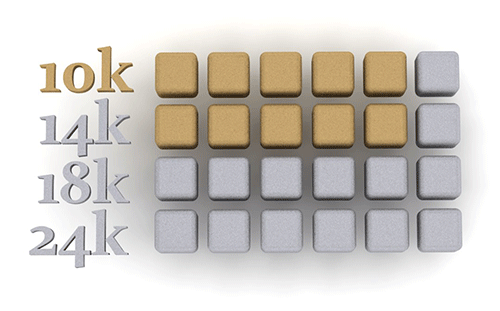What's up doc? A guide to the karat, what is karat gold, anyway?
October 1, 2021
You've probably eaten a carrot. You've probably heard of 14 karat gold. You've probably heard people talk about a 1 carat diamond. Carat, karat, carrot? What's the difference anyway? What does it all mean? Don't worry, we can shed some light on this situation and make it all make sense.
Let's get the easiest one out of the way first, a carrot is an orange vegetable. You should always eat your vegetables.
A carat, the one that starts with a C, is a unit of measure most often used to measure diamond weight. It weights 1/5 of a gram and was originally derived from the weight of carab seeds which are apparently so consistent in their weight that they were used to measure gemstones. We'll get to that one in another post.
The karat
A karat though, the one with the K, is a measure of the purity of gold. Since pure gold is very soft, and not always suitable for every application, it is alloyed with different metals to give it different characteristics. Some gold is alloyed to make it appear bright white or a rose tone instead of yellow. When gold is alloyed, the karat gold will allow you to determine how much gold is in a piece and how much of the material is another alloy.
Karat gold is made up of 24 parts, so 24k gold is like 100% gold. Are you ready to find out what karat gold you've most likely to run into? Here's our list:
24 karat gold: We covered this above.
24k gold is 100% pure gold. It doesn’t include traces of any other metal. It has a beautiful distinct bright yellow color and because of its purity it is naturally more expensive than any other gold karat. One downside to 24k gold is that its extremely soft/bendable which makes it unsuitable for most jewelry.

22 karat gold: This gold alloy is comprised of 22 parts gold (91.67%) and 2 parts alloy (8.33%). Common metals used as gold alloys include metals like silver, zinc, nickel. 22k is not preferable when making jewelry because it is still extremely soft and bendable to be able to properly secure gemstones. Jewelry pieces make up of 22k gold are generally the type you wear only on occasion.
18 karat gold: This gold alloy is comprised of 18 parts gold (75%) and 6 parts alloy (25%). It is commonly used in high end jewelry and has a beautiful rich yellow tone. Its higher gold content makes it more suitable for individuals with metal allergies, however these pieces do scratch more easily.
14 karat gold: This gold alloy is comprised of 14 parts gold (58.3%) and 10 parts alloy (41.7%). This is probably the most common karat gold you see fine jewelry made from. It is usually less expensive than higher karat gold and can be a softer shade of yellow because of the slightly lower gold content, though it can also be alloyed to be white, rose, and even green. The presence of alloyed metals makes 14k more resistant to daily wear and tear because it is harder and more durable. This gold karat is great for those with active lifestyles that would like to wear their jewelry daily. (disclaimer: you should still probably not be wearing your jewelry while exercising and doing manual labor)
10 karat gold: This gold alloy is comprised of 10 parts gold (41.7%) and 14 parts alloy (58.3%). Making 10k the only gold karat that has a higher presence of alloyed metals than gold content. Which also makes it less precious, however, that does make it more cost effective! This alloy of gold is extremely sturdy.
Less than 10 karat gold isn't legally allowed to be sold as gold in the United States. The FTC has decided that once you get below 10k gold, the gold content is too low to be sold as "go
So, which is the best you ask?
Don't ask us that, you know how we feel about gold! They're all the best! Well, maybe a better way to say it would be that it really depends on your style, budget, and how you'd like to wear any given piece. There are many factors that will help you decide which karat gold is best for you. Now you know the difference though. If you've got more questions, feel free to drop us a line though, we'd love to hear from you and we're full of answers.